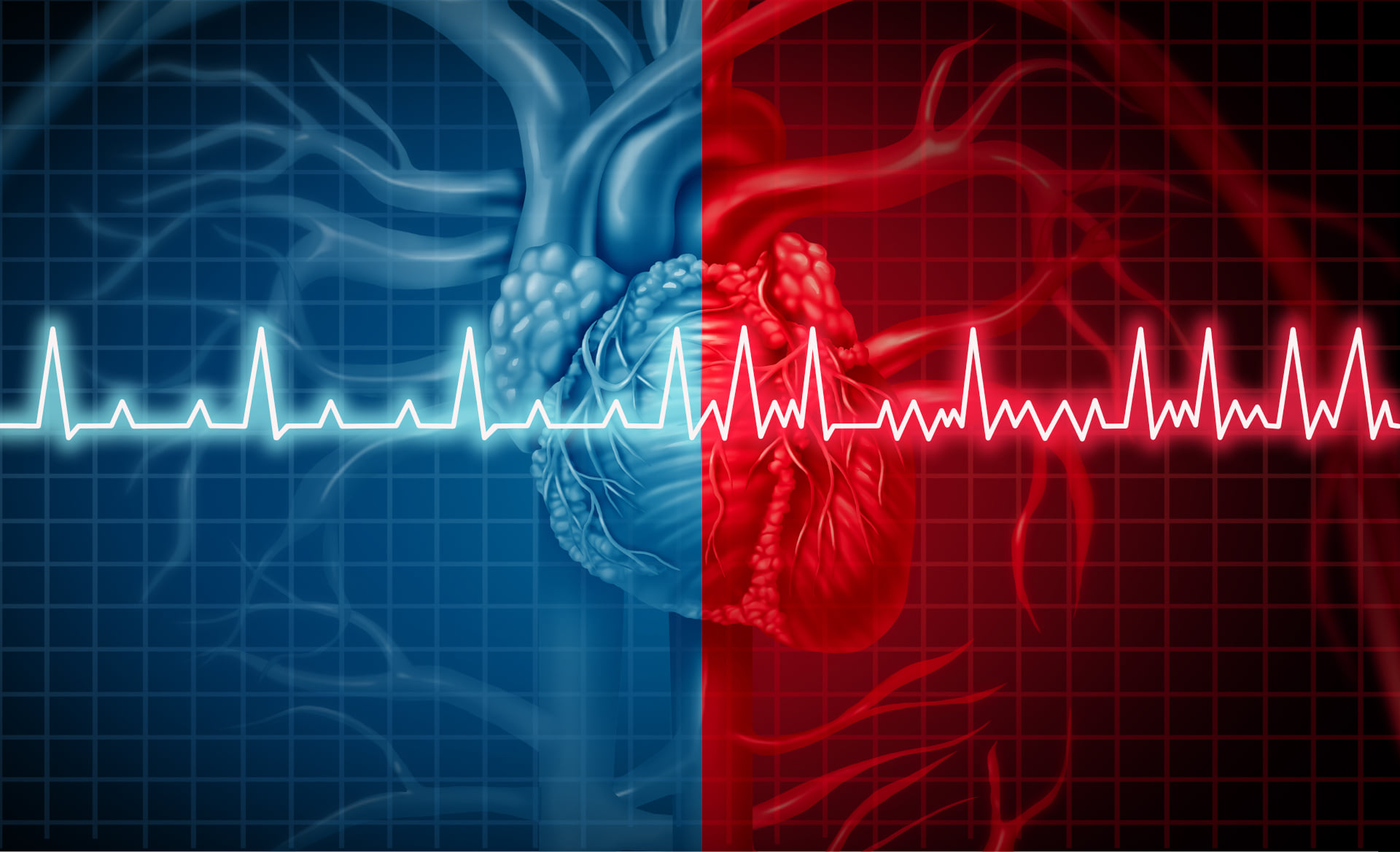Disturbance of frequency and rhythm
If you suspect a change in the heart rhythm, it is important to consult a specialist as soon as possible in order to clarify whether and which form of cardiac arrhythmia is present.
If you suffer from a dangerous arrhythmia, we will work with you to find the appropriate treatment to eliminate the risks and improve your quality of life and symptoms.
Atrial fibrillation is the most common heart rhythm disorder in adults worldwide. Left untreated, atrial fibrillation increases the risk of heart failure and stroke. Take good care of your heart health and seek advice at regular intervals.
How do cardiac arrhythmias develop?
Cardiac arrhythmias can develop at different points in the heart. If a disturbance is present at one site, an irregular pulse, also called arrhythmia, develops, which can cause different symptoms.
A healthy heartbeat begins in the sinus node and is transmitted through the conduction system. The sinus node is the natural pacemaker of the heart. The conduction system is the electrical network that transmits the impulse to the heart muscle.
Common causes of arrhythmias include: Coronary artery disease (CAD), heart attack, myocardial disease, valvular heart disease, hypertension, thyroid dysfunction, lung disease, stress, and overindulgence in alcohol and coffee.
Who is affected by cardiac arrhythmias?
Cardiac arrhythmias are found more frequently in younger patients with certain risk factors, in trained endurance athletes, and with increasing age. However, they can also occur completely spontaneously. It is not uncommon for an irregular heart rhythm to be discovered by chance, for example during a routine check-up.
What are the symptoms of an arrhythmia?
The symptoms can be very different and are often perceived very differently. Every patient is individual. There are people who don't notice terrible arrhythmias - and then there are people who already feel little misfires. It is very different - everyone is different. We basically differentiate between slow, fast, regular and irregular cardiac arrhythmias.
Recognize symptoms
The symptoms of a cardiac arrhythmia can be very individual. There are people who suffer from dangerous cardiac arrhythmias but do not notice them - others notice even small, isolated extra beats of the heart and are very worried. The type of arrhythmia is also a decisive factor.
Slow heartbeat - bradycardia
In slow arrhythmias, the heart rate falls below 60 beats per minute. Nevertheless, there does not necessarily have to be a disease. Even endurance athletes can have a constantly low heart rate. If a pause between two heartbeats lasts longer than three seconds, or if symptoms occur, this requires immediate clarification.
Symptoms: Fatigue, listlessness, heart palpitations, dizziness, lightheadedness, shortness of breath, brief loss of consciousness, and transient visual or speech disturbances.
Fast heartbeat - tachycardia
The heart normally beats faster when it needs to perform. However, if this condition persists during rest, it is unhealthy because the heart muscle becomes exhausted. If the heart beats more than 100 beats per minute, we speak of a tachycardic arrhythmia.
Isolated heartbeats outside the basic rhythm are also called extrasystoles. In most cases, these are noticeable as a heartbeat. However, these "isolated heartbeats outside the basic rhythm" can also be atrial flutter, atrial fibrillation or life-threatening ventricular tachycardia.
Symptoms: Palpitations, racing heart, nervousness, dizziness, fainting, shortness of breath, inner turmoil and a collapse.
Irregular heartbeat - atrial fibrillation
An irregular heartbeat occurs either in atrial fibrillation, or due to isolated extra beats. In atrial fibrillation, the heart beats in an uncoordinated manner, the cause being that the atria no longer contract regularly. This absolute arrhythmia can no longer be regulated by the sinus node. Atrial fibrillation is often clearly perceptible to patients.
Symptoms: a perceived irregular heartbeat and pulse, heart palpitations, palpitations, dizziness, sweating, shortness of breath, inner restlessness, anxiety, fatigue, chest pain, fatigue, impaired performance or even a stroke.
Are cardiac arrhythmias dangerous?
Isolated irregularities of the heartbeat can be perfectly normal. Every one of us has them from time to time. However, only a heart specialist can usually decide whether more frequent cardiac arrhythmias are relevant. For some time now, there have also been electronic helpers such as smartwatches, which can make certain analyses. However, we strongly advise you to always consult a doctor directly if you have any suspicions.
When should the heart be examined more closely?
If cardiac arrhythmias occur more frequently or over a longer period of time, the cause should be clarified. Especially if these cardiac arrhythmias have an impact on your performance. Complications can be avoided by an early examination.
What happens during the examination?
First, a medical history is taken. In a joint discussion with the physician, medically relevant information is discussed in order to better understand the respective symptoms and situations. This serves as an initial assessment for causes and existing problems.
This is followed by a physical examination including heart sounds and heart murmurs with a stethoscope. Heart valve defects that can be heard in this way can also be the cause of cardiac arrhythmias.
Subsequently, an electrocardiogram (ECG) is made. This is an absolutely painless way of describing the electrical activity of the heart on the surface of the body and analyzing the heart rhythm. Often, a blood test is also ordered. If relevant, an ultrasound examination of the heart can also be performed.
